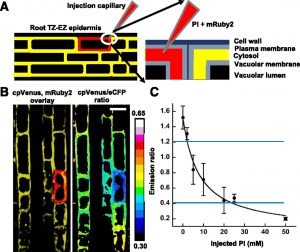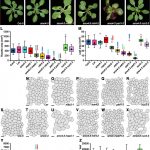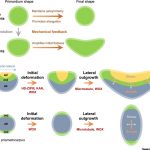On the Inside: Spatial Dynamics of Pi Distribution in Roots
 The availability of inorganic phosphate (Pi) often limits plant growth and crop productivity. The signaling mechanisms governing Pi starvation responses in plants include responses to external Pi concentrations to modify the root system architecture and responses to internal Pi concentrations to maintain Pi homeostasis. How these signaling mechanisms are coordinated is unclear but Pi itself is regarded as a primary signal. Thus, to better understand how plants cope with deficient and variable supplies of Pi, Sahu et al. (10.1104/pp.20.01008) have used imaging techniques to spatially resolve and quantify cytosolic Pi concentrations in Arabidopsis (Arabidopsis thaliana) roots. The authors show that cytosolic Pi concentrations differ between developmental zones, with the highest levels occurring in the transition zone, and that this distribution pattern is independent of Pi supply. The Pi concentrations, however, were more or less equivalent in the epidermis, cortex, and endodermis within each zone. The authors also examined the contributions of Pi uptake and metabolic recycling to cytosolic Pi levels by blocking Pi assimilation with cyanide. Similar experiments conducted with a vacuolar Pi uptake mutant, suggest that developmental differences in vacuolar sequestration are responsible for the observed pattern of Pi distribution in the root. These results highlight the complexity of Pi dynamics in live plants and revealed developmental control of root Pi homeostasis, which has potential implications for plant sensing and signaling of Pi.
The availability of inorganic phosphate (Pi) often limits plant growth and crop productivity. The signaling mechanisms governing Pi starvation responses in plants include responses to external Pi concentrations to modify the root system architecture and responses to internal Pi concentrations to maintain Pi homeostasis. How these signaling mechanisms are coordinated is unclear but Pi itself is regarded as a primary signal. Thus, to better understand how plants cope with deficient and variable supplies of Pi, Sahu et al. (10.1104/pp.20.01008) have used imaging techniques to spatially resolve and quantify cytosolic Pi concentrations in Arabidopsis (Arabidopsis thaliana) roots. The authors show that cytosolic Pi concentrations differ between developmental zones, with the highest levels occurring in the transition zone, and that this distribution pattern is independent of Pi supply. The Pi concentrations, however, were more or less equivalent in the epidermis, cortex, and endodermis within each zone. The authors also examined the contributions of Pi uptake and metabolic recycling to cytosolic Pi levels by blocking Pi assimilation with cyanide. Similar experiments conducted with a vacuolar Pi uptake mutant, suggest that developmental differences in vacuolar sequestration are responsible for the observed pattern of Pi distribution in the root. These results highlight the complexity of Pi dynamics in live plants and revealed developmental control of root Pi homeostasis, which has potential implications for plant sensing and signaling of Pi.



